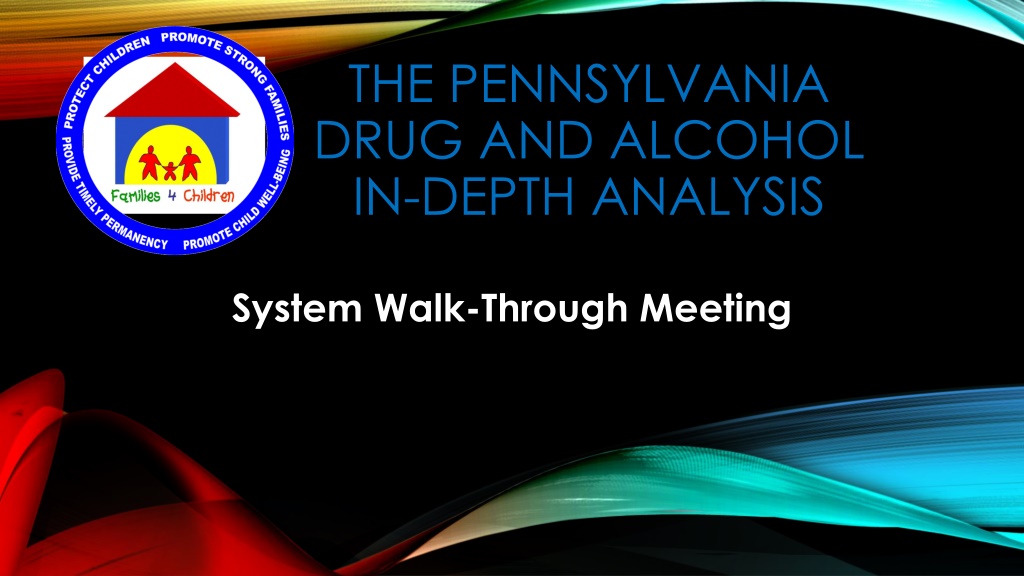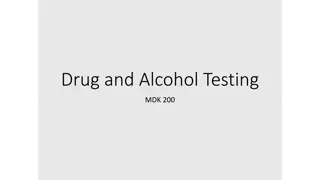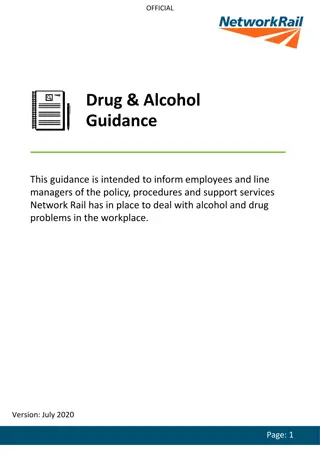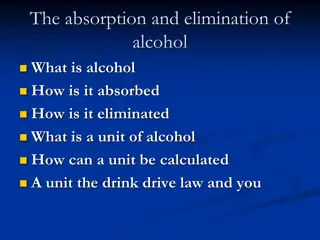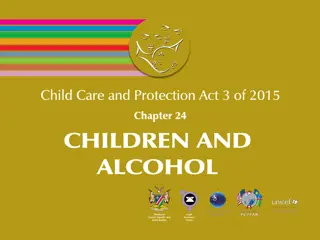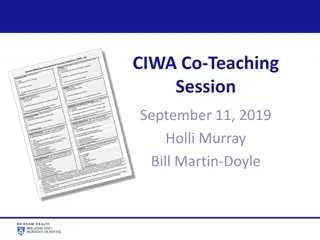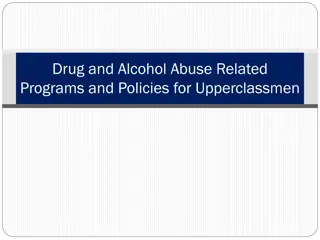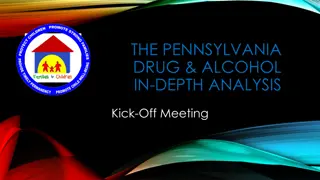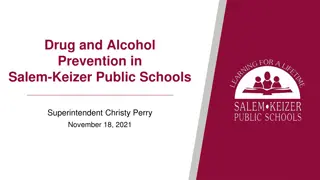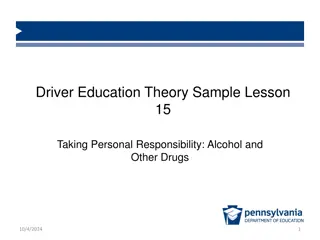Pennsylvania Drug and Alcohol In-Depth Analysis System Overview
Explore the Pennsylvania Drug and Alcohol In-Depth Analysis System through a comprehensive walk-through meeting agenda. Understand collaborative values, survey results, baseline data, county insights, and strategies for obtaining missing data. Dive into case file reviews to grasp the impact of substance use on child welfare outcomes and parental care decision-making.
Download Presentation

Please find below an Image/Link to download the presentation.
The content on the website is provided AS IS for your information and personal use only. It may not be sold, licensed, or shared on other websites without obtaining consent from the author. Download presentation by click this link. If you encounter any issues during the download, it is possible that the publisher has removed the file from their server.
E N D
Presentation Transcript
THE PENNSYLVANIA DRUG AND ALCOHOL IN-DEPTH ANALYSIS System Walk-Through Meeting
AGENDA FOR SYSTEM WALK-THROUGH Welcome & Introductions Collaborative Values Inventory Results Baseline Cross-System Data Case File Review Drop-Off Analysis Questions?
COLLABORATIVE VALUES INVENTORY An anonymous way to explore values and beliefs to facilitate the development of common principles using data collection. Purpose: To assist in clarifying the underlying values in collaborative work To uncover differences in values that may impede future progress in cross-system collaboration To assist in the development of common principles and goals
COLLABORATIVE VALUES INVENTORY SURVEY RESULTS
INITIAL CROSS-SYSTEM BASELINE DATA Purpose: To determine the prevalence of families with substance use disorders in the child welfare system and its incidence in child welfare outcomes. To identify the extent to which families in the child welfare system with substance use disorders are being referred and receive treatment.
COUNTY DATA Were there surprises in the data now that you are seeing child welfare and substance abuse data together? What might the data begin to tell you about your target population? What didn t it tell you?
FOR DATA NOT READILY AVAILABLE Do you have any suggestions, such as sampling case records, to obtain some of the missing data? Are there any other data you think are needed at this time to obtain a valid profile of your county? Are there data collection issues with which you need help at the state level?
PURPOSE OF CASE FILE REVIEW To understand what role parental/caregiver substance use had in each case and how it affected permanency planning and disposition To understand what factors supported or impeded whether or not the parent/caregiver received substance use assessment and/or treatment services if it was indicated To understand what may have been done differently in the life of the case to improve outcomes for children of parents with substance use disorders
HOW FINDINGS WILL BE USED Findings from the case file reviews will assist in determining: Where and how earlier identification of families with substance use disorders (SUD) case be undertaken; How to better connect families with SUD to assessments in a timely fashion; How to connect families with SUD to timely treatment, and clinically indicated level of care;
HOW FINDINGS WILL BE USED What is needed to reach timely permanency outcomes for children and families while providing opportunities to keep children safely at home or reunify them in a timely manner; How to keep families with SUD engaged so they can receive a sufficient dosage of treatment; and To conditions that contribute to the best outcomes for children, parents and families.
CASE FILES TO BE PULLED Sample Size Margin of Error A margin of error tells you how many percentage points your results will differ from the real population value. For example, a 90% confidence interval with a 10 percent margin of error means that your statistic will be within 10 percentage points of the real population value 90% of the time. Confidence Level Number of Reports that Resulted in Investigations in 2018 = ? Confidence Level of 90% with 10% Margin of Error Number of files to be randomly pulled= ?
CASE REVIEW PARAMETERS All randomly selected files must include the following characteristics in the final sample count: All cases were active in the previous year. Have the choice to pull cases from ALL of the previous year, or cases which were active only in the LAST TWO QUARTERS of the previous year, depending on what is needed to reach the recommended sample size. Cases were opened in or before Quarter 3 of calendar year the previous year to be eligible. 30% of the final sample were court involved families.
PURPOSE OF DROP-OFF ANALYSIS Method used to assess the linkages among child welfare, treatment agencies and courts by identifying connections that families need to make between system to obtain services and achieve their child welfare case goals. At each state of the families hand-offs between the systems, agencies using the drop-off analysis collect data to determine how many families to not connect for services.
HOW DATA WILL BE USED The Drop-Off Analysis will assist in determining: The extent to which families in child welfare systems with substance use disorders are being identified, and referred for assessment and treatment services; and The extent of drop-off between the different processes in the drop-off analysis; and Inform partnerships where engagement strategies need to be implemented to increase access to and successful completion of treatment, and subsequently, improved outcomes for children and families.
DROP OFF ANALYSIS EXAMPLE 1000 Cases that Resulted in an Investigation (~700 Parents) 500 (71%) Parents Referred for Assessment 350 (70%) Parents Screened (150 Refused Screening) 225 (64%) Admitted to Treatment 175 (78%) In Treatment for 90 Days 100 (44%) In Continuous Treatment 75 (33%) Completed Treatment 40 (53%) Reunified & 30 (40%) Remained at Home 5 (6%) Pending Permanency)
NEXT STEPS FOR YOUR COUNTY Identify Needs, Concerns, existing or Emerging Issues Identify Potential Barriers, Contextual Issues and Potential Solutions Identify Priority Areas for Improving Cross-System Collaboration Select Effective Programs, Strategies & Tools Prepare Finding and Recommendations and Draft Goals and Objectives and present to your local Children s Roundtable Finalize Work Plan & Implement Evaluate Results to Determine if Outcomes have been Met Establish Next Steps to Continue to Improve Quality
